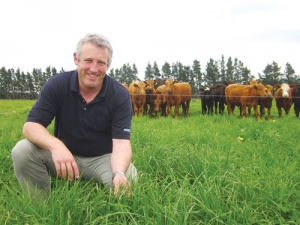Wired for Science: Understanding the feeding habits of mealybug
Fussy children might be frustrating, but fussy mealybugs could help protect the New Zealand wine industry from grapevine leafroll-associated virus 3.
 Inaccurate yield measurements of fodder beef will lend to inaccurate feed allocations and serious animal health issues, warns animal nutritionalist Glenn Judson.
Inaccurate yield measurements of fodder beef will lend to inaccurate feed allocations and serious animal health issues, warns animal nutritionalist Glenn Judson.
Farmers need to accurately determine fodder beet yields in order to maximise gains and minimise risk.
This was one of the key messages reiterated by Agricom animal nutritionist Dr Glenn Judson at the recent Marshdale field day.
Looking to the difficulty in determining absolute measurements on yield, Judson cautions farmers that inaccurate yield measurements will lead to incorrect allocations – a serious issue for stock during the transition phase. This phase is the first 10-14 days a herd is transitioned onto the crop and is critical as rumen acidosis can occur as a result of over-consumption of fodder beet before the rumen has adapted.
As an example, the transition programme developed at Lincoln University, via the Dairy NZ fodder beet project, starts cows on 1.2kgDM of fodder beet allocated on the first day. This is increased by 1kgDM every second day for 14 days. Supplement inputs begin at 8kgDM on day 1, dropping to 4kg by day 14 and down to 2-3kg by day 21.
Judson says due to rumen acidosis typically occurring during the transition period, it is vital that DM yields are as accurate as possible to prevent occurrence. Signs of rumen acidosis are depression, dehydration, scouring, bloating, milk fever and sudden death.
He says any affected cows should be immediately removed and put onto pasture for treatment.
Judson advises that in order to minimise risk, the transition face itself needs to be focused on: it is better to over estimate yields rather than to under estimate. He suggests the most accurate way to do this is by working at 3-4 tonne either side of mean.
Although fodder beet is a precision sown crop, it will still not have 100% germination or 100% emergence and therefore gaps are inevitable. To calculate DM and get within 3t of true mean, Judson recommends taking eight samples in a paddock with a standard deviation of 4.3.
A paddock with a standard deviation of 5.4 would require 13 samples. If only eight were taken in this instance, Judson believes you would likely only get as close as 4.5 tonne either side of true mean. He warns that farmers, in doing this, risk over feeding stock during this phase.
However, the high yields that make the crop so popular can come at a cost. Judson warns that the more you crop, the lower your potential yield. The higher winter stocking rate means soil structure damage and degradation occurs a lot faster.
As a result, Agricom does not recommend sowing consecutive crops of fodder beet. Doing so may lead to the same situation as with brassicas where diseases have been encouraged.
The company also advises farmers when choosing a paddock, to ensure there has been no recent history of chemical use as fodder beet is very sensitive to residual chemicals.
By accurately determining fodder beet yields, farmers can maximise liveweight gain through a more precise feed allocation, Judson believes.
He says the high palatability of fodder beet encourages high intakes and with an ME of 12 MJ/kg DM it has strong associated BCS gains. Further, with a strong focus on management and planning, the risks associated with fodder beet can be greatly minimised.
Arable growers worried that some weeds in their crops may have developed herbicide resistance can now get the suspected plants tested for free.
Fruit growers and exporters are worried following the discovery of a male Queensland fruit fly in Auckland this week.
Dairy prices have jumped in the overnight Global Dairy Trade (GDT) auction, breaking a five-month negative streak.
Alliance Group chief executive Willie Wiese is leaving the company after three years in the role.
A booklet produced in 2025 by the Rotoiti 15 trust, Department of Conservation and Scion – now part of the Bioeconomy Science Institute – aims to help people identify insect pests and diseases.
A Taranaki farmer and livestock agent who illegally swapped NAIT tags from cows infected with a bovine disease in an attempt to sell the cows has been fined $15,000.